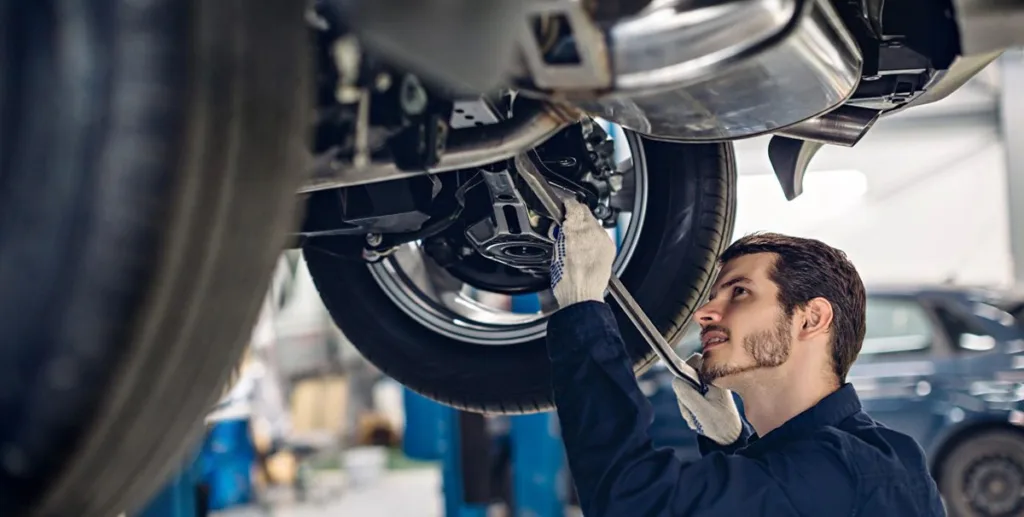All Categories
Featured
Your vehicle's suspension system is a vital part that boosts your driving experience by offering comfort, control, and security. Below's a detailed guide to maintaining your suspension system in excellent shape.
![]()
Leaking Fluid: Oil around the struts or shocks shows they might require replacement. Harmed Springs: Splits or breaks in the springs can trigger uneven vehicle height. Rust or Deterioration: Steel elements like control arms and bushings are vulnerable to rust with time. If you discover any kind of problems, have your suspension system evaluated by a professional technician.
Maintain tires pumped up to the recommended stress. Turn tires every 5,000 to 7,500 miles. Balance and straighten wheels every year or after hitting aesthetics or potholes. Unequal tire wear is an usual sign of suspension imbalance or used components.
![]()
Conclusion. Proper upkeep of your suspension system is important for guaranteeing a risk-free and comfortable driving experience. By performing routine examinations, changing used components, preserving tire care, and driving responsibly, you can keep your suspension in peak condition. Proactive treatment not only prevents pricey repair services yet additionally guarantees your automobile's durability and safety and security for every single journey.
- Comprehend the Significance of the Shock Absorber. The shock absorber takes in shocks from unequal roads, supports the car's weight, and keeps the tires strongly in call with the roadway. It includes shocks, shows off, springs, control arms, and bushings, all of which collaborate to ensure a secure and smooth adventure. Recognizing its relevance is the initial step towards appropriate treatment.
- Conduct Normal Aesthetic Assessments. Frequent aesthetic checks can help determine prospective issues early. Search For:

Leaking Fluid: Oil around the struts or shocks shows they might require replacement. Harmed Springs: Splits or breaks in the springs can trigger uneven vehicle height. Rust or Deterioration: Steel elements like control arms and bushings are vulnerable to rust with time. If you discover any kind of problems, have your suspension system evaluated by a professional technician.
- Address Uncommon Noises and Symptoms. Uncommon sounds, such as creaking, squeaking, or clunking, typically signal suspension problems. A bouncy experience, problem guiding, or the automobile pulling to one side shows that a suspension part could require focus. Don't overlook these indicators; early discovery can avoid additional damage.
- Maintain Appropriate Tire Treatment. Tires and suspension interact to supply a smooth ride. To decrease anxiety on your suspension system:
Maintain tires pumped up to the recommended stress. Turn tires every 5,000 to 7,500 miles. Balance and straighten wheels every year or after hitting aesthetics or potholes. Unequal tire wear is an usual sign of suspension imbalance or used components.
- Replace Worn-Out Parts on Time. Suspension parts like shocks, struts, and bushings use out in time. Manufacturers commonly recommend replacing shocks and shows off every 50,000 to 100,000 miles, depending upon driving problems. Postponing substitute can compromise handling, safety, and general lorry performance.

- Stay Clear Of Overloading Your Vehicle. Exceeding your lorry's weight capacity places excessive stress on the shock absorber. This can result in faster tear and use on parts like shocks and springs. Constantly examine your proprietor's handbook for weight limitations and stay clear of overloading.
- Drive Sensibly. Aggressive driving habits, such as speeding over holes, taking corners also quick, or regularly driving on rough roads, can harm your suspension. Technique careful driving to lessen wear and expand the life-span of your shock absorber.
- Set Up Professional Evaluations. Regular specialist examinations are vital for determining hidden problems and ensuring optimum performance. Technicians can identify troubles that aren't visible during a do it yourself check, such as used round joints or control arm damages.
Conclusion. Proper upkeep of your suspension system is important for guaranteeing a risk-free and comfortable driving experience. By performing routine examinations, changing used components, preserving tire care, and driving responsibly, you can keep your suspension in peak condition. Proactive treatment not only prevents pricey repair services yet additionally guarantees your automobile's durability and safety and security for every single journey.
Latest Posts
Find Out the Montclare Advantage - Trusted Auto Repair
Published Apr 19, 25
2 min read
Full Circle Strategic Marketing - Expand Sales Opportunities with Targeted Marketing Solutions
Published Apr 19, 25
2 min read
Save Big with Montclare Auto Repair Offers - Available for a Short Time!
Published Apr 18, 25
2 min read
More
Latest Posts
Find Out the Montclare Advantage - Trusted Auto Repair
Published Apr 19, 25
2 min read
Full Circle Strategic Marketing - Expand Sales Opportunities with Targeted Marketing Solutions
Published Apr 19, 25
2 min read
Save Big with Montclare Auto Repair Offers - Available for a Short Time!
Published Apr 18, 25
2 min read